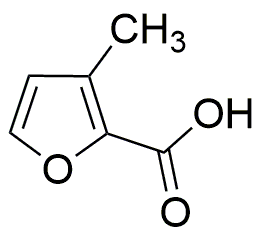3-Methyl-2-furancarboxylic acid is widely utilized in research focused on:
- Food Industry: This compound serves as a flavoring agent, enhancing the taste profile of various food products, particularly in baked goods and beverages.
- Pharmaceuticals: It is used in the synthesis of bioactive compounds, contributing to the development of new medications with improved efficacy and reduced side effects.
- Bioplastics: The chemical plays a role in creating biodegradable plastics, offering an eco-friendly alternative to conventional plastics and addressing environmental concerns.
- Aromatherapy: Its pleasant aroma makes it valuable in the production of fragrances and essential oils, providing natural scent solutions for personal care products.
- Research Applications: It is utilized in organic synthesis and chemical research, aiding scientists in developing new materials and studying reaction mechanisms.
Informations générales
Propriétés
Sécurité et réglementation
Applications
3-Methyl-2-furancarboxylic acid is widely utilized in research focused on:
- Food Industry: This compound serves as a flavoring agent, enhancing the taste profile of various food products, particularly in baked goods and beverages.
- Pharmaceuticals: It is used in the synthesis of bioactive compounds, contributing to the development of new medications with improved efficacy and reduced side effects.
- Bioplastics: The chemical plays a role in creating biodegradable plastics, offering an eco-friendly alternative to conventional plastics and addressing environmental concerns.
- Aromatherapy: Its pleasant aroma makes it valuable in the production of fragrances and essential oils, providing natural scent solutions for personal care products.
- Research Applications: It is utilized in organic synthesis and chemical research, aiding scientists in developing new materials and studying reaction mechanisms.
Documents
Fiches de données de sécurité (FDS)
La FDS fournit des informations de sécurité complètes sur la manipulation, le stockage et l’élimination du produit.
Spécifications du produit (PS)
Le PS fournit une description complète des propriétés du produit, notamment sa composition chimique, son état physique, sa pureté et les exigences de stockage. Il détaille également les plages de qualité acceptables et les applications prévues du produit.
Certificats d'analyse (COA)
Recherchez des certificats d'analyse (COA) en saisissant le numéro de lot du produit. Les numéros de lot et de lot se trouvent sur l'étiquette d'un produit, après les mots « Lot » ou « Lot de fabrication ».
Numéro de catalogue
Numéro de lot/série
Certificats d'origine (COO)
Ce certificat d'exploitation confirme le pays dans lequel le produit a été fabriqué, et détaille également les matériaux et composants utilisés et s'il est issu de sources naturelles, synthétiques ou autres sources spécifiques. Ce certificat peut être requis pour les douanes, le commerce et la conformité réglementaire.
Numéro de catalogue
Numéro de lot/série
Fiches de données de sécurité (FDS)
La FDS fournit des informations de sécurité complètes sur la manipulation, le stockage et l’élimination du produit.
DownloadSpécifications du produit (PS)
Le PS fournit une description complète des propriétés du produit, notamment sa composition chimique, son état physique, sa pureté et les exigences de stockage. Il détaille également les plages de qualité acceptables et les applications prévues du produit.
DownloadCertificats d'analyse (COA)
Recherchez des certificats d'analyse (COA) en saisissant le numéro de lot du produit. Les numéros de lot et de lot se trouvent sur l'étiquette d'un produit, après les mots « Lot » ou « Lot de fabrication ».
Numéro de catalogue
Numéro de lot/série
Certificats d'origine (COO)
Ce certificat d'exploitation confirme le pays dans lequel le produit a été fabriqué, et détaille également les matériaux et composants utilisés et s'il est issu de sources naturelles, synthétiques ou autres sources spécifiques. Ce certificat peut être requis pour les douanes, le commerce et la conformité réglementaire.


